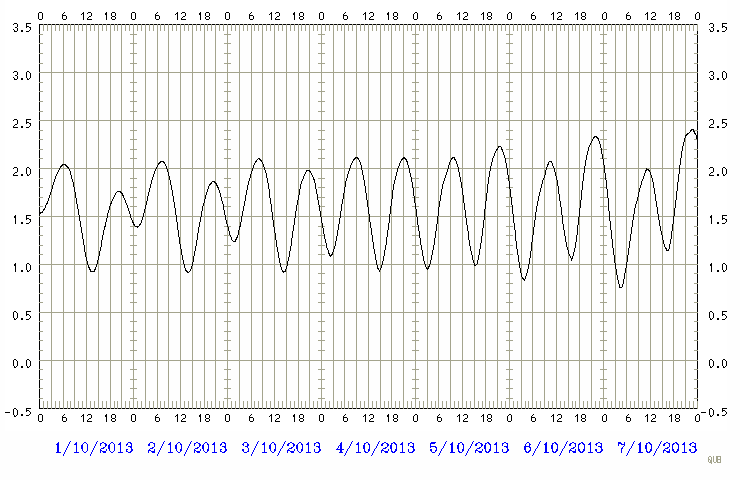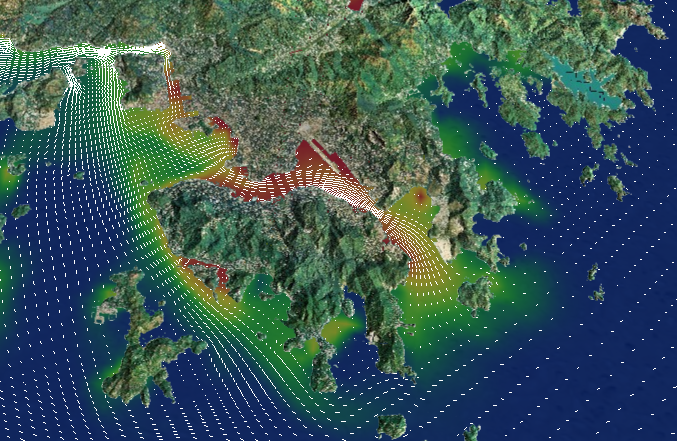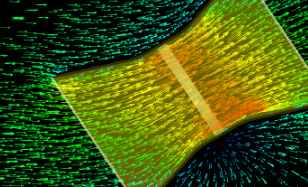Hong Kong Situation
Hong Kong's tidal regime
Hong Kong's tidal regime is mainly
semi-diurnal (and mixed) with, for most days of the month, 2 high tides and 2 low tides. The tidal range is 1.4m.
As we can see from the
amphidromic systems map, Hong Kong’s tidal range is expected to be low when compared to North-West Europe for example.

A low tidal range does not necessarily imply slow currents. The strength of currents is forged by many other factors, such as the local topography.
Hong Kong currents are relatively modest on average, but it is possible to increase the flow velocity and make its energy conversion viable by using a site with a suitable topography and/or a device with a suitable design (see sections below).
Local Topography and Climatic Factors
With its numerous islands, Hong Kong currents are forced into several narrow channels accelerating the flow velocity (jet stream). This means that the best possible locations for device deployment are expected to be between 2 islands.

In the South China Sea (SCS), marine current patterns and strengths vary greatly throughout the year due to the northeastern (dry winter) monsoon and more powerful southwestern (wet summer) monsoon.
Extreme weather conditions, including typhoons, occur seasonally but irregularly affecting all HK waters. Tidal currents are generally stronger during summer (wet season), which is also the time where energy demand peaks in Hong Kong (mainly due to space cooling systems).
Appropriate Device Designs
Ducted turbines
 Hong Kong has relatively modest tidal current velocities. However, international research efforts have recently focused on a promising technology for converting modest tidal currents: ducted turbines. The duct increases the flow speed around the turbine (the power available from a large area is concentrated in a smaller area), allowing a greater electricity output.
Hong Kong has relatively modest tidal current velocities. However, international research efforts have recently focused on a promising technology for converting modest tidal currents: ducted turbines. The duct increases the flow speed around the turbine (the power available from a large area is concentrated in a smaller area), allowing a greater electricity output.
Usually, tidal currents are pointing towards 2 main directions (one during the ebb, the other during the flow), making a double-ducted bi-directional turbine possibly the most viable design.
Mooring System
Submerged devices: previous research (see project outcomes) concerning Hong Kong waters have indicated that currents are on average stronger when closer to the seabed on several locations.
Also, a submerged device (gravity base, seabed fixed, or pole mounted) allows navigation above it, and protects the device against extreme weather conditions such as typhoons.
Use of existing submerged structures: it is possible to attach a device to an existing submerged structure, such as the pillar of a bridge to reduce installation costs. Attaching it to an offshore wind turbine would further reduce installation costs by combining the 2 renewables that would share the same grid-connection system.
With its coasts and islands, Hong Kong already has a fair number of existing bridges. The massive Hong Kong Zhuhai Macau Bridge that will cross the Pear River Estuary could bring new device mooring possibilities. There are also 2 offshore wind farm projects underway.
 A low tidal range does not necessarily imply slow currents. The strength of currents is forged by many other factors, such as the local topography.
A low tidal range does not necessarily imply slow currents. The strength of currents is forged by many other factors, such as the local topography.
 In the South China Sea (SCS), marine current patterns and strengths vary greatly throughout the year due to the northeastern (dry winter) monsoon and more powerful southwestern (wet summer) monsoon.
In the South China Sea (SCS), marine current patterns and strengths vary greatly throughout the year due to the northeastern (dry winter) monsoon and more powerful southwestern (wet summer) monsoon.
 Hong Kong has relatively modest tidal current velocities. However, international research efforts have recently focused on a promising technology for converting modest tidal currents: ducted turbines. The duct increases the flow speed around the turbine (the power available from a large area is concentrated in a smaller area), allowing a greater electricity output.
Hong Kong has relatively modest tidal current velocities. However, international research efforts have recently focused on a promising technology for converting modest tidal currents: ducted turbines. The duct increases the flow speed around the turbine (the power available from a large area is concentrated in a smaller area), allowing a greater electricity output.